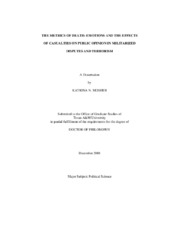| dc.description.abstract | Recent terrorist events (e.g., London, Madrid, and Bombay train bombings), as well as the attacks on September 11, 2001, have highlighted the impact casualties can have on domestic audiences. These incidents led to major foreign policy shifts, massive security expenditures, and the removal of an incumbent government (i.e., Spain). Yet, when we compare the number of those killed in terrorist events to those killed in militarized disputes, there are more negative public responses to casualties of terrorism than to militarized disputes. My dissertation examines this “over reaction” by comparing reactions to different casualty contexts. The comparison of casualties across different hostility contexts is a unique contribution to the field.
I posit a model in which the characteristics of the casualty event generate emotional reactions. The emotional response affects the way information about the event is processed by individuals, and alters individual’s support of aggressive/non-aggressive foreign policies. Furthermore, my model proposes that different types of negative emotions have different impacts on the process, as well as on the preferences for distinct foreign policies. I expect that different casualty characteristics such as the hostility context (terrorism and militarized disputes) and the characteristics of the targets (number killed and their identity) influence the specific negative emotions experienced by individuals. Thus, variations in these characteristics should alter public preferences for foreign policies.
I use a multi-method approach to test my theoretical propositions. First, I utilize experimental methods that introduce different scenarios to the participants. Each scenario varies the casualty characteristics, and measures individual preferences for foreign policies. Second, I compiled a daily event data set that contains both terrorism and militarized dispute casualty statistics and public reaction data for Israel in 1969. This period provides wide variations along the independent variables. My results support the idea that casualty characteristics play a pivotal role in emotional responses to these events as well as in how individuals respond to casualty events. This work is unique in that it examined the role of the number of casualties in conjunction with the context in which they occur and who those casualties are. | en |


